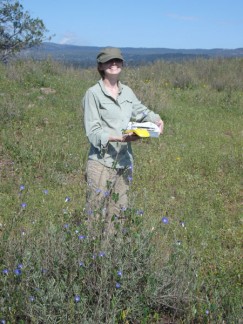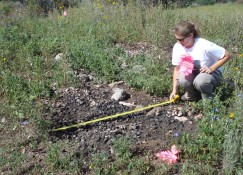- Home
- >
- Preservation Archaeology Blog
- >
- Preservation Archaeology in Action
 |
By Deborah L. Huntley, Preservation Archaeologist
|
What can be learned about an archaeological site without digging? Quite a lot, it turns out, especially if that site has been kept in pristine condition.
I recently visited such a site that is managed by the National Park Service (NPS). Although this large pueblo has been documented and mapped, it has never been excavated—or looted. Because this site probably had a 13th century Salado occupation, I am very interested in its relationship to other sites with Salado occupations in the Cliff, Mimbres, and Mule Creek areas.
In 2009, I visited the site with a crew of three archaeologists. We had several goals. First, we wanted to get a sense of the site’s architecture and overall layout. We knew that there was a large Mimbres Classic occupation, and we wanted to see if the later Salado occupation overlapped that or was in a discrete portion of the site. Second, by identifying the types of pottery on the site surface, we could determine site occupation dates and track long-distance connections. Finally, the NPS had planned to do a controlled burn in an area that included the site, and they wanted us to assess the effects of this burn on surface artifacts and architecture.

To help us measure surface artifact visibility before and after the burn, we set up several 5 by 2 meter transects. We used compass and tape to measure these, and we also recorded their locations with a GPS unit. We then counted every single sherd we could find in each transect and recorded its type. We also counted all of the obsidian (volcanic glass) artifacts we found. There were a lot of sore knees and aching backs at the end of the day!
We were allowed to collect a sample of obsidian artifacts for sourcing as part of Preservation Fellow Rob Jones’ dissertation research. We also collected a sample of Salado Polychrome sherds for compositional analysis using Neutron Activation Analysis at the University of Missouri Research Reactor. (I’ll write another blog post on this work soon.) This is part of our larger study of ceramic production and exchange in the Upper Gila region.
The controlled burn did not happen as planned, but a wildfire earlier this year burned much of the site’s surface. My crew and I returned last weekend to find a lush landscape of wildflowers punctuated by burned tree stumps. It seems that the fire moved quickly over the site’s surface, burning dead grass and dry vegetation, but the effects of the fire were very patchy. It was particularly intense wherever there were packrat middens—piles of dried wood, stones, and other items collected by these industrious rodents.

We were surprised that only a small portion of surface artifacts and architectural stones had any sooting or charring. We were happy to find that, despite all of the new vegetation, surface ground visibility was much better than when we visited in 2009. For example, in one transect we counted 223 sherds in 2009; in 2011, we counted 390 sherds!
Pottery and architecture give us some important clues to when the site was occupied and by whom. We can tell that the site was in use as early as the A.D. 550s (the late Pithouse period), had a large Mimbres Classic (A.D. 1000–1130) population, and had a smaller Postclassic (A.D. 1130–1300) occupation. At least some portion of the site was probably settled by a Salado group in the 1300s.
Non-local sherds from many different time periods tell us that site occupants had ties with ancestral Pueblo groups in the Cibola region to the north, as well as with groups in the southern deserts along the Chihuahuan borderlands. Ongoing compositional analysis and obsidian sourcing will tell us even more about long-distance connections and changing social affiliations.
Explore the News
-
Join Today
Keep up with the latest discoveries in southwestern archaeology. Join today, and receive Archaeology Southwest Magazine, among other member benefits.